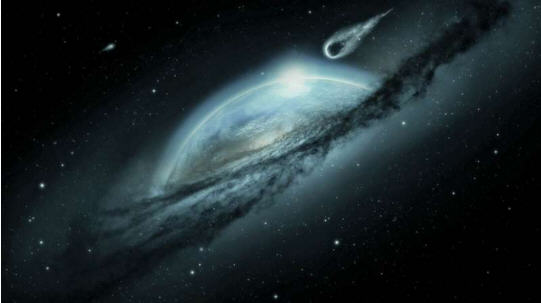博文
澳中美科学家发现了巨大陨石撞击形成大陆的证据
 精选
精选
||
澳中美科学家发现了巨大陨石撞击形成大陆的证据
诸平
Credit: Pixabay/CC0 Public Domain
据澳大利亚科廷大学(Curtin University)2022年8月10日报道,澳中美科学家发现了巨大陨石撞击形成大陆的证据(Evidence that giant meteorite impacts created the continents)。相关研究结果于2022年8月10日已经在《自然》(Nature)杂志网站发表——Tim E. Johnson, Christopher L. Kirkland, Yongjun Lu, R. Hugh Smithies, Michael Brown, Michael I. H. Hartnady. Giant impacts and the origin and evolution of continents. Nature, 2022, 608: 330–335. DOI: 10.1038/s41586-022-04956-y. Published: 10 August 2022. http://www.nature.com/articles/s41586-022-04956-y
参与此项研究的有来自澳大利亚西澳洲珀斯的科廷大学(Curtin University, Perth, Western Australia, Australia)、西澳大利亚地质调查局(Geological Survey of Western Australia, Perth, Western Australia, Australia)、西澳大利亚大学(The University of Western Australia, Crawley, Western Australia, Australia);中国地质大学(China University of Geosciences, Wuhan, China)、美国马里兰大学(University of Maryland, College Park, MD, USA)的研究人员。
澳中美研究人员合作完成的新研究,提供了迄今为止最有力的证据,表明地球大陆是由巨大的陨石撞击形成的,这种撞击在地球45亿年历史的头10亿年左右特别普遍。
科廷大学地球与行星科学学院(Curtin's School of Earth and Planetary Sciences)的蒂姆·约翰逊博士(Dr. Tim Johnson)说,大陆最初形成于巨大陨石(meteorite)撞击的地点的观点已经存在了几十年,但到目前为止,几乎没有可靠的证据支持这一理论。
“通过检查西澳大利亚皮尔巴拉克拉通(Pilbara Craton in Western Australia)岩石中锆石(zircon)矿物的微小晶体,我们发现了这些巨大陨石撞击的证据,它们代表着地球上保存最完好的古地壳(ancient crust)遗迹,”蒂姆·约翰逊说。
“对这些锆石晶体中氧同位素组成的研究,揭示了一个‘自上而下’的过程('top-down' process),从地表附近的岩石融化开始,然后进一步深入,这与巨型陨石撞击的地质效应(geological effect)相一致。
我们的研究提供了第一个确凿的证据,表明最终形成大陆的过程始于巨大的陨石撞击,与导致恐龙灭绝的过程类似,但发生在数十亿年前。”
蒂姆·约翰逊博士说,了解地球大陆的形成和持续演化是至关重要的,因为地球上大部分的生物、所有的人类和几乎所有重要的矿藏都在这些大陆上。
“重要的是,这些大陆上蕴藏着锂(lithium,Li)、锡(tin, Sn)和镍(nickel, Ni)等关键金属,这些大宗商品对于新兴的绿色技术(green technologies)至关重要,需要它们来履行我们减轻气候变化( climate change)的义务,”蒂姆·约翰逊说。
“这些矿藏(mineral deposits)是地壳分化过程的最终结果,这一过程始于最早的大陆块的形成,皮尔巴拉克拉通只是众多大陆块中的一个。与地球上其他地区的古大陆地壳相关的数据,似乎显示出了与西澳大利亚州相似的模式。我们想测试我们在这些古老岩石上的发现,看看我们的模型是否如我们所怀疑的那样更广泛地适用。”
这项工作得到了西澳大利亚政府勘探奖励计划(Western Australian Government Exploration Incentive Scheme)的支持。通过澳大利亚研究委员会发现和联系项目{ Australian Research Council Discovery (DP200101104) and Linkage (LP180100199) projects},获得了科廷大学的支持和澳大利亚政府的资助。
上述介绍,仅供参考。欲了解更多信息,敬请注意浏览原文或者相关报道。
Lasers light the way to discovery of ancient crust beneath Western Australia
Earth is the only planet known to have continents, although how they formed and evolved is unclear. Here using the oxygen isotope compositions of dated magmatic zircon, we show that the Pilbara Craton in Western Australia, Earth’s best-preserved Archaean (4.0–2.5 billion years ago (Ga)) continental remnant, was built in three stages. Stage 1 zircons (3.6–3.4 Ga) form two age clusters with one-third recording submantle δ18O, indicating crystallization from evolved magmas derived from hydrothermally altered basaltic crust like that in modern-day Iceland1,2. Shallow melting is consistent with giant impacts that typified the first billion years of Earth history3,4,5. Giant impacts provide a mechanism for fracturing the crust and establishing prolonged hydrothermal alteration by interaction with the globally extensive ocean6,7,8. A giant impact at around 3.6 Ga, coeval with the oldest low-δ18O zircon, would have triggered massive mantle melting to produce a thick mafic–ultramafic nucleus9,10. A second low-δ18O zircon cluster at around 3.4 Ga is contemporaneous with spherule beds that provide the oldest material evidence for giant impacts on Earth11. Stage 2 (3.4–3.0 Ga) zircons mostly have mantle-like δ18O and crystallized from parental magmas formed near the base of the evolving continental nucleus12. Stage 3 (<3.0 Ga) zircons have above-mantle δ18O, indicating efficient recycling of supracrustal rocks. That the oldest felsic rocks formed at 3.9–3.5 Ga (ref. 13), towards the end of the so-called late heavy bombardment4, is not a coincidence.
https://blog.sciencenet.cn/blog-212210-1351043.html
上一篇:机器人在弯曲空间中的运动违反标准物理定律
下一篇:科学家为可持续重新设计食品系统提供了蓝图
